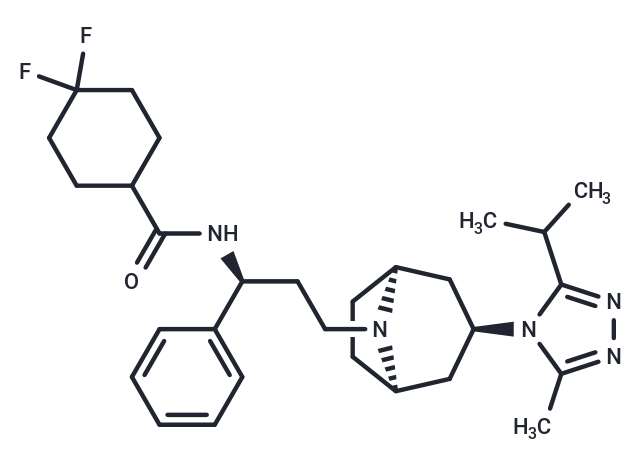Shopping Cart
- Remove All
 Your shopping cart is currently empty
Your shopping cart is currently empty


| Pack Size | Price | Availability | Quantity |
|---|---|---|---|
| 5 mg | $47 | In Stock | |
| 10 mg | $87 | In Stock | |
| 25 mg | $163 | In Stock | |
| 50 mg | $287 | In Stock | |
| 100 mg | $517 | In Stock | |
| 200 mg | $667 | In Stock | |
| 500 mg | $1,050 | In Stock | |
| 1 mL x 10 mM (in DMSO) | $54 | In Stock |
| Description | Maraviroc (Selzentry) is a C-C Chemokine Receptor Type 5 (CCR5) antagonist, and for MIP-1α(IC50=3.3 nM), MIP-1β (IC50=7.2 nM) and RANTES(IC50=5.2 nM).Maraviroc inhibits HIV-1 entry via CCR5 coreceptor interaction. |
| Targets&IC50 | MIP-1β:7.2 nM, MIP-1α:3.3 nM, RANTES:5.2 nM |
| In vitro | In canines, oral administration of Maraviroc at a dosage of 2 mg/kg resulted in peak concentrations of 256 ng/ml at 1.5 hours with a bioavailability of 40%. In rats, the half-life of Maraviroc was approximately 0.9 hours, with around 30% of the administered dose being absorbed from the intestine. Experiments in female RAG-hu mice demonstrated that Maraviroc provided complete protection against HIV-1 infection. |
| In vivo | Maraviroc (IC50=7-30 nM) inhibits the downstream intracellular calcium redistribution induced by chemokines in MIP-1β, MIP-1α, and RANTES. |
| Kinase Assay | Inhibition of chemokine binding to CCR5: Binding of 125I-labeled MIP-1α, MIP-1β, and RANTES to CCR5 is measured using intact HEK-293 cells stably expressing the receptor or membrane preparations thereof. Briefly, cells are resuspended in binding buffer (50 mM HEPES containing 1 mM CaCl2, 5 mM MgCl2, and 0.5% bovine serum albumin [BSA] and adjusted to pH 7.4) to a density of 2 × 106 cells/ml. For membrane preparations, phosphate-buffered saline (PBS)-washed cells are resuspended in lysis buffer (20 mM HEPES, 1 mM CaCl2, 1 tablet COMPLETE per 50 mL, pH 7.4) prior to homogenization in a Polytron hand-held homogenizer, ultracentrifugation (40,000× g for 30 min), and resuspension in binding buffer to a protein concentration of 0.25 mg/mL (12.5 μg of membrane protein is used in each well of a 96-well plate). 125I-radiolabeled MIP-1α, MIP-1β, and RANTES are prepared and diluted in binding buffer to a final concentration of 400 pM in the assay. Maraviroc dilutions are added to each well to a final volume of 100 μL, the assay plates incubate for 1 hour, and the contents filter through preblocked and washed Unifilter plates which are counted following overnight drying. |
| Cell Research | Drug susceptibility assays are performed in 24-well tissue culture plates. Duplicate eight-point dilution series of Maraviroc are prepared in DMSO and medium to yield a final DMSO concentration of 0.1% (vol/vol) in the assay. PHA-stimulated PBMC or PM-1 cells are infected with virus for 1 hour at 37 °C. Cells are subsequently washed once, and 3.6 × 105 PBMC or 2.0 × 105 PM-1 cells are added to each well of assay plates containing diluted Maraviroc. Plates are incubated for 5 days (lab-adapted strains) or 7 days (primary isolates) at 37 °C in a humidified 5% CO2 (vol/vol) atmosphere.(Only for Reference) |
| Alias | Celsentri, UK-427857, Selzentry |
| Molecular Weight | 513.67 |
| Formula | C29H41F2N5O |
| Cas No. | 376348-65-1 |
| Storage | Powder: -20°C for 3 years | In solvent: -80°C for 1 year | Shipping with blue ice. | |||||||||||||||||||||||||||||||||||
| Solubility Information | DMSO: 55 mg/mL (107.07 mM) Ethanol: 51.4 mg/mL (100 mM) | |||||||||||||||||||||||||||||||||||
Solution Preparation Table | ||||||||||||||||||||||||||||||||||||
Ethanol/DMSO
| ||||||||||||||||||||||||||||||||||||

Copyright © 2015-2024 TargetMol Chemicals Inc. All Rights Reserved.